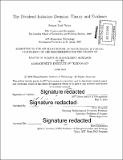| dc.contributor.advisor | Nittai Bergman. | en_US |
| dc.contributor.author | Thakor, Richard Todd | en_US |
| dc.contributor.other | Sloan School of Management. | en_US |
| dc.date.accessioned | 2015-12-03T20:52:03Z | |
| dc.date.available | 2015-12-03T20:52:03Z | |
| dc.date.copyright | 2015 | en_US |
| dc.date.issued | 2015 | en_US |
| dc.identifier.uri | http://hdl.handle.net/1721.1/100078 | |
| dc.description | Thesis: S.M. in Management Research, Massachusetts Institute of Technology, Sloan School of Management, 2015. | en_US |
| dc.description | Cataloged from PDF version of thesis. | en_US |
| dc.description | Includes bibliographical references (pages 72-76). | en_US |
| dc.description.abstract | This paper develops and tests a dynamic, sequential equilibrium model of corporate cash payout policy that endogenizes a firm's dividend initiation decision, and its extreme reluctance to subsequently cut dividends in a sequential equilibrium. After payment of dividends, all excess cash is disgorged via stock repurchases that elicit no price reactions. The theoretical model generates results consistent with many stylized facts related to dividend initiations, including: a positive announcement effect associated with a dividend initiation; a larger (in absolute value) negative announcement effect for a dividend cut/omission than for an initiation; and a probability of dividend initiation that is increasing in the firm's profitability and assets in place, and decreasing in the personal tax rate on dividends relative to capital gains. The model also generates additional novel predictions, one of which is that the probability of dividend initiation is decreasing in managerial ownership of the firm, and this effect is stronger the weaker is (external) corporate governance. A second novel prediction is that the dividend initiation probability is decreasing in the potential loss in value from the "two-audience-signaling" information disclosure costs associated with secondary equity issues. These new predictions are tested empirically using a predictive logit model of dividend initiations. Moreover, the paper tests and finds additional empirical support for the information-disclosure result using a regression discontinuity design. | en_US |
| dc.description.statementofresponsibility | by Richard Todd Thakor. | en_US |
| dc.format.extent | 76 pages | en_US |
| dc.language.iso | eng | en_US |
| dc.publisher | Massachusetts Institute of Technology | en_US |
| dc.rights | M.I.T. theses are protected by copyright. They may be viewed from this source for any purpose, but reproduction or distribution in any format is prohibited without written permission. See provided URL for inquiries about permission. | en_US |
| dc.rights.uri | http://dspace.mit.edu/handle/1721.1/7582 | en_US |
| dc.subject | Sloan School of Management. | en_US |
| dc.title | The dividend initiation decision : theory and evidence | en_US |
| dc.type | Thesis | en_US |
| dc.description.degree | S.M. in Management Research | en_US |
| dc.contributor.department | Sloan School of Management | |
| dc.identifier.oclc | 928912450 | en_US |
